by Jennifer Hughes
Bass players always seem to be in the background, except for a very few that take the stage front and center. This is why many bass players seem so mysterious, and why some myths abound about them and bass playing in general. Some bassists may have even believed these myths themselves before they picked up the bass, after which they eventually learned the truth.
So what are the most popular myths about learning and playing the bass and what’s the truth behind them?
You should start out on the cheapest bass guitar you can find.
If you’re a beginner, it’s generally not a good idea to go for the lowest-priced model you can buy. Bass guitars on the lowest rung of the price tier tend to be poorly made and can only give you frustration instead of enjoyment when playing. Instead, go for reasonably priced basses that are recommended for beginners. These bass models are of a sturdy build and good sound quality, plus they’re wallet-friendly but not too cheaply priced as to make you doubt their quality.
The bass is easier to play than the guitar.
The bass may only have four strings compared with the electric guitar’s six, but that doesn’t make it any easier to learn to play properly. It’s a different instrument that’s played differently from the electric guitar. Playing the bass requires a different knowledge base and skill set, so to speak. So no, the bass isn’t necessarily easier to play than the electric guitar.
If you can’t play the guitar, then just play bass.
This is somewhat connected to the myth above. While there are some bass players who transitioned from guitar to bass, that doesn’t mean they failed as guitar players. Some guitarists who are used to playing leads may even find it difficult to play bass. Circumstances differ, but in some cases a bassist picked up the bass because it was necessary, or because there was no one else to not only play it, but play it well.
John Deacon, during his pre-Queen years in a band called The Opposition, played the bass notes on his guitar because their bassist wasn’t that good. Eventually, like Paul McCartney some years earlier, he took up the bass full-time.
Being able to read music is a must for bass players.
Uhm, nope – but it’s a plus, especially if your goals include building a music career that requires you to read music, such as teaching or transcribing your compositions. Being able to read and understand musical notation is definitely useful knowledge in order to comprehend music theory fully, but you can play the bass without reading music.
Bass players get stuck in the background.
This may be the reputation of bass players in rock bands just because the lead vocalist is more active on stage, and frankly many bass players would only be too happy to be out of the spotlight.
The truth of the matter is they may not look that uppity on stage but they’re the reason why you’re bobbing your head and grooving to the music. They’re like the puppet masters behind the curtain, focusing on their craft to make everything move for your enjoyment. They’re not stuck in the background – they chose to be somewhere they can take control and drive the music forward.
We hope those help in putting matters in the right perspective. What other bass myths have you heard and what are the truths that debunk them? Share them with us!
by Amanda Pollak
I was 16 when I decided I’d had enough of being shy.
Growing up, attention was a nerve-wracking imposition. As a child in school, I refrained from raising my hand in class even when I knew the answer just to avoid making myself known to others. I was very content playing alone in my room for hours, letting the world’s gaze pass me by.
In high school,; I began to resent my bashfulness and saw it fit to amend this aspect of my personality. I meditated on what scared me most: being on stage, hot lights blinding, everyone watching. So into drama class I enrolled.
It came easy for everyone else. I stood in awe of the Theater Kids™ who effortlessly flourished in the spotlight, who were funny without trying, who were loud without remorse. I coveted their ability to unapologetically exist. I was always so sorry for the space I took up.
My first play was held in my high school’s cafeteria. We were in the round, people on all sides of me. I knew my lines backwards and forwards after spending weeks in my room learning them before my shifts at the Dairy Queen. My armpits were the sweatiest they’ve ever been. I remember zipping through the crowd to get to my place on stage in my stiff dress, hoping no one noticed said armpits. I had a minor role. I didn’t mess up, yay! Probably not the most riveting performance, but the parents clapped nonetheless.
That summer I attended an acting program in New York City, and a year later I left for college 700 miles away from home where I knew no one. This forced me to Put Myself Out There and eventually my shyness began to erode. While in college I joined an improv comedy troupe and started working at a local news station where I regularly approached strangers and convinced them to be on TV. The remaining scraps of shyness receded.
Until I became a musician.
The first time I played publicly, a year after beginning lessons, was at one of Freeway Music’s student showcases at the Music Farm; this particular one was especially massive given that it had morphed into an all-day music festival of sorts. As much as I loved music and was eager to experience performing, this environment was a literal nightmare actualized.
I wish I could impose upon you, dear reader, the all-consuming, unrelenting anxiety that descended upon me before the performance, because I lack the parlance to fully convey it; in fact, I’m getting nervous all over again just recounting it. I practiced one song for weeks, yammering on to anyone who would listen about just how nervous I was, and did they think I was ready to do this? WHAT IF I MESSED UP? On the day of this blessed event I refused all food and drink. I couldn’t stop pacing the unforgiving concrete floors of Music Farm, feeling the state of my armpits worsen by the minute. All the confidence I’d amassed in the years prior was, for some reason, not applicable here.
I envisioned every way in which this could go wrong, even though I had spent countless hours practicing, even though I had been listening to this particular song for years and even though making a mistake actually isn’t the worst possible offense in the universe. I had arrived super early meaning I had to wait for several hours before I was slated to play. Honestly, it was sort of miserable–like perpetually climbing up the initial hill of a roller coaster, wondering when the bottom would drop out. I ran my hands over my sticks. I tapped the beat on my thighs while I watched the others. I prayed.
Finally it was my turn. I remember walking up the stairs to the stage and approaching the drum set, but here’s where things get a bit fuzzy–you see, I was so monumentally nervous that I don’t actually remember playing–I must have functioned on autopilot for those few moments. But I know I did it because a friend (thanks, Sara!) took a video of me playing, flub-free and on beat. My memory resumes after the song is finished and I headed over to my friends and more or less collapsed.
I am relieved to report that since that fateful afternoon, it has become much, much easier to perform live. While some environments still intimidate me (ahem, Speakeasy), as time passes and I grow more confident and skilled, the stage feels more like home, and I feel worthy of being on it.
I write this not to evoke pity or sympathy, but rather to highlight the evolution I believe we are all capable of, even the most withdrawn among us, and to encourage anyone who feels inclined to music but reticent to perform that perhaps a push towards the spotlight would do you some good. I once believed that the immense turmoil I experienced before performing meant I somehow wasn’t cut out for music–especially when I’d see kids a quarter of my age gleefully belt out a song without hint of hesitation.
But for musicians, and for all of us, really–each journey is unique. Each of us will master a skill that our neighbor might painstakingly fumble through, and our neighbor might breeze past us in other ways. Managing nerves is merely another proficiency, like running through scales or playing with a metronome. Preparation is the antidote for performance anxiety.
So if you have the chance to take the stage, go for it. You’ll survive. You’ll be better for it. Just bring some good deodorant.
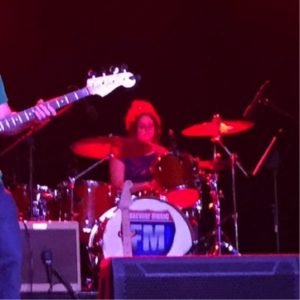
Music Farm, 2014: Nope, I actually don’t remember this.
by Amanda Pollak
Confession: I tell most people I started playing drums four years ago. That isn’t exactly true.
The more accurate answer is that I took my first lesson with Tony Lee back in 2009, before Freeway Music existed and Tony was teaching in a tastefully decorated, rectangular stand-alone building on Devine Street called Two Four Drum Studio.
Back in those days, Tony wouldn’t let you near a kit until you could demonstrate proficiency on a practice pad, which is an uninspiring circular fusion of rubber and plastic used to hone your technique and sticking. I had no idea such a thing even existed, and Tony’s prescribed pedagogy was a clear diversion from what I expected. Um, hello, wasn’t he aware that I was supposed to be learning how to ROCK?!
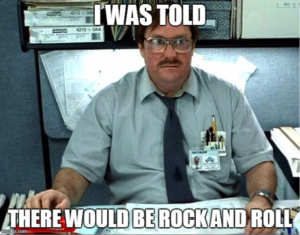
Pictured above: me, at my first lesson
I quit after only a few lessons for a variety of reasons, namely because I had no disposable income nor space for a drum set, but my intrigue for percussion remained dormant for a few years until that fateful evening at Speakeasy where I decided I was going to try again. Something something following your dreams.
By now, Freeway Music was established and Tony’s dominion had evolved into a quaint brick office building with an entire floor dedicated to furthering musicianship across the Midlands. Upon walking into his new space, I was delighted to see an *actual drum kit, and even more delighted when we began my lesson by sitting down in front of said kit. Perhaps he had moved past that whole technique fixation and recognized that at long last, it was FINALLY time for me to rock. *Editor’s note: Tony would like to point out that his original location also had a drumset; usually, two kits were set up.
You see, I believed I was special, for I had been told that I had a natural inclination towards drums; a good sense of time and coordination; therefore, because I was so clearly ~*naturally talented*~ I had no need for this plebeian peasantry of working on rudiments and paying attention to my grip and my wrists. And of course, Tony would immediately realize just how advanced I was and would have to rework his approach because I was going to blow all of his expectations out of the water.
Yeah, no. I sucked at drums. I dropped the beat. I made rookie mistakes. I didn’t hold my sticks right (and still kinda don’t, heh). I had an ego which needed to be put in check.
Learn from me, friends. No matter your age or musical background, I believe there a few ideas from which all students may benefit before they play their very first note.
1. It isn’t going to be fun all the time.
When you’re watching your favorite guitar player shred on stage, just remember that for every minute you look upon him in awe, he has spent many, many minutes, hours, days, even years, practicing. Scales, chords, simple songs, running the same part over and over until his fingers bleed. It sure is fun to imagine yourself thrashing on stage, making people in the audience scream and cry and whatnot–but that comes later…after many hours holed up in your room, after a number of flubs in public, after trying to master a part that you Just. Can’t. Get. (but eventually you will), and that will make all the other boring, non-fun parts of learning totally worth it.
2. You might have natural talent–but you’ll still have to work at it.
Hey you, kid (or adult) who’s about to take music lessons. You’re special! And unique! You’re probably going to do great at whatever instrument you’ve chosen! Somewhere along the line someone may have told you that you’re really good at the bass or the clarinet or the piano, and I’m sure they’re not wrong, but don’t let that get to your head, mmkay? Your teacher isn’t assigning you things to practice because she can’t see how awesome you are; she’s assigning you things to practice because no matter how much talent you start off with, music has lots of things that need to be practiced. I guarantee that any musician you admire has already realized this. They weren’t born that good!
3. It’s your path–no one else’s.
Every now and then a video will pop up on Facebook of a 5-year-old who can play Led Zeppelin’s entire anthology on a drumset bigger than my apartment while riding on the back of an elephant or something, and I have a moment of defeat where I wonder why I even bother at all. As an adult who’s 4 years in, while many people my age have been playing most of their lives, I wrestle with comparing myself to others a lot. But then I remember how far I’ve come since I began, and how I can do things today that just a few months ago were beyond me. Making the decision to learn an instrument is one of the best decisions I’ve ever made in my life, and I hope it will be for you, too. It’s very easy to get caught up in what everyone else is doing, but if you work hard, practice consistently, develop a positive attitude (that means you’re easy to work with–no divas, please!), and conduct yourself professionally, you’ll be shocked at how far that can take you.
Because if your goal is to truly play an instrument, and not just fool yourself into thinking you do, there are no shortcuts.
Stay tuned for There Are No Shortcuts, Part II: What I Had to Learn the Hard Way.
“NAMM” is short for National Association of Music Merchants, but I thought it would be a fun exercise to describe my experience there with alternative words for the acronym sprinkled throughout. Enjoy.
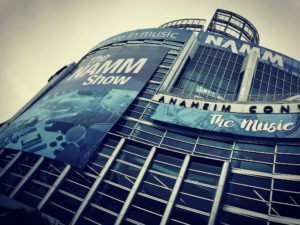
Negative App Mention Moment
To say the NAMM show is an incredibly well-attended event is an epic understatement, because the amount of people converging on the Anaheim Convention Center is mind boggling. Not only are there the attendees, which include exhibitors, buyers, guests of exhibitors and buyers, and the general public; but also, there is the army of support staff. It is truly the most impressive example of organization on a grand scale that I have ever witnessed. The official NAMM app…well, let’s just say that it needs a little work. Though it has a few bugs, I feel sure they will get it addressed, and it’s, at least, a very useful curation of info.
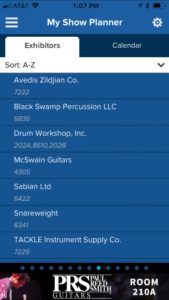
Anyway, as a Neophyte Ambling and Meandering Meticulously through its well-appointed layout, I was like the proverbial kid in a candy store. I took two approaches to discovering “my NAMM.”
1) I plotted out specific booths that I wanted to check out based on my interests.
2) I put my iPhone in my pocket and just wandered, getting into an organic “NAMM flow.”
I enjoyed the latter method more. It allowed me to experience the overall vibe much more easily and put into perspective the dynamic occurring between all the booths, the people occupying them, and the synergy of NAMM (NAMM-ergy).
*It’s a NAMM thing to describe as many facets of the event by incorporating its one-syllable acronym into the description, NAMM-ese, if you will.
While I was Naturally Agape at the Mammoth Magnificence of NAMM, I managed to utilize the app to create a list of booths to visit in “My Show Planner.” My list included mostly percussion vendors, because I am a drummer. First up was the Zildjian booth. Their cymbals and recent acquisition of Vic Firth meant that I could get a lot of perusing done at one booth. Well, the new K Sweet Collection took up more time than I had plotted in My Show Planner! The sounds coming out of these cymbals were incredibly versatile. Personally, I have two cymbal groupings for my gigs: rock and jazz. “Rock” means that I will be testing the upper limits of volume and energy. “Jazz” means that I will be testing the lower limits of volume and expression. The gigs can overlap somewhat, but I definitely don’t want to play “expressively’ on my rock setup and I would never want to push my more sophisticated plates into those upper limits of volume. Well, these K Sweet cymbals were easy to imagine being able to handle all of the above!

Relatively/strategically adjacent to the Zildjian booth, Sabian built a wall of cymbals to landmark their territory. Their FRX line of cymbals, with their unlathed bells and concentric circles of holes spreading from the bell outwards, give the impression that Sabian took their Quiet Tone low volume concept and applied it to actual cymbals, but no…they’re more than that. What’s missing, besides tiny circles of cymbal alloy, are the frequencies that cause so much strife in live and recording situations. Plexiglass shields were created BECAUSE of these frequencies. Well, these cymbals address the unfortunate temple-piercing range with ease. No more headaches for everyone in earshot and no more transparent cages of Lucite needed!
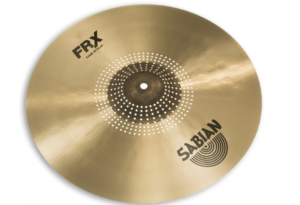
Besides Navigating Amid Metallurgical Manufacturers, I was excited about visiting a couple of accessories vendors. Tackle Instrument Supply Company offers canvas and leather accessories for drummers. Their stick and cymbal bags are classic and modern simultaneously. They are high quality, simple designs that stand out among similar products from other companies. I especially appreciated the buckles and chunky YKK zippers. Sharing a booth with Tackle was Low Boy Custom Beaters, a company that specializes in custom bass drum beaters. These products are eye-catching and high quality! They offer a wide variety of options, but all are crafted from maple and have a rounded cone shape. You can choose between three materials for the striking side of the beater: felt, leather, or wood. What a great touch to complete a drum set! It’s in the details, folks.
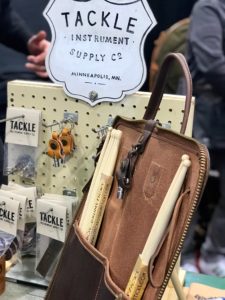
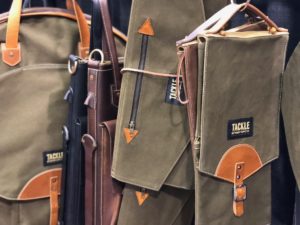
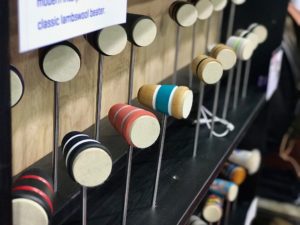

So, after realizing what a difference New Accessories Might Make to my drumming life (yours too), I was even more excited to stop by the Snareweight booth. There, I met Mat, the guy responsible for inventing and developing this amazing snare dampening system, and Ruben, Mat’s NAMM-sistant (helping Mat while on leave from Tesla…no lie). The product is simple, eye-catching, and high quality. The original version is a two-piece, solid brass device that attaches to the drum rim magnetically. The combination of its actual weight (3/4 lb.) and the detachable leather inserts creates a variety of dampening options. In addition to this nifty invention, Mat has created a leaner version that clips onto the rim and comes with either leather or mylar inserts. Not only are there multiple combinations of materials, but also each version can be customized; thanks to strategically placed rivets, you can magnetically “fold” the leather version and the mylar version can be cut to suit your needs. Simply brilliant design and execution! I was lucky enough to leave with a customized M1 Snareweight (Thanks, Mat!) and I can’t wait to use it on my Rocket Boom snare drum at my next gig.
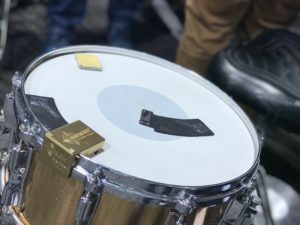
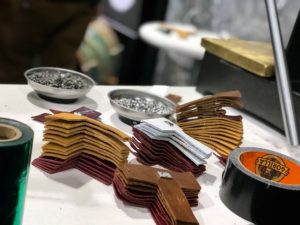
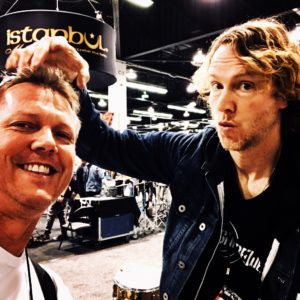
Once I checked off my predetermined list, I decided to let go and let NAMM. I wandered through the areas without a destination and it was awesome! I stopped to check out products that caught my eye and/or my ear. My first carefree discovery was a product called “Stick Pro.” I talked with Don, its inventor, briefly about the advantages of this simple device you slide on the sticks and place your index finger through. The “constraint” they provide is not only an advantage, physics-wise, but also a great “grip orthotic.” So, I bought a pair and have been using them with much success with my students. Check it out!
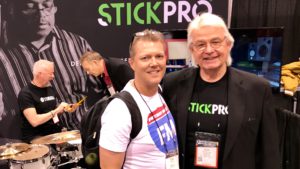
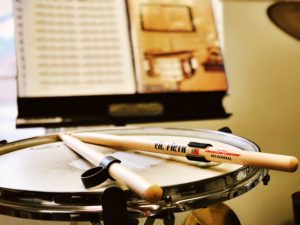
There are plenty of drums on display, of course, but two companies caught my eye. Black Swamp Percussion and Doc Sweeney Drums. Top quality construction and materials are established facts for any successful instrument maker that makes it to this floor, so what is going to stand out? Style stands out. Style is an extension of your personality, of course. These drums and their aesthetic resonated with me (pun intended). I was able to speak with Patrick Sweeney and Steve Stecher of Doc Sweeney Drums, which only further established my positive opinion of their company and drums. Everything is personal when it comes to our gear. I will be reaffirming my relationship with these guys by buying drums from them.

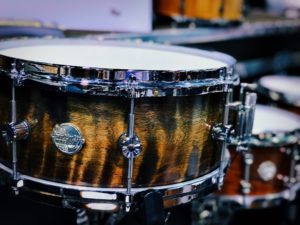
Yamaha’s EAD10 (Electronic Acoustic Drums) is worth checking out for so many reasons. It’s revolutionary, really. As a drum module, you can record your drums at high quality and share in whatever way you can imagine. Recording, practicing alone, rehearsing with a group, videos for social media…the enhanced possibilities are exciting. This one is a game changer.
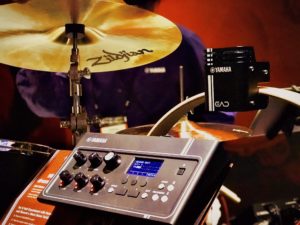
There were more products (and impromptu performances) that grabbed my attention, but that’s plenty for now. I will be more than happy to talk about any of these topics with you the next time we see each other.
Lastly…Never Accept Mediocre Memories.
Until next year, NAMM!
By Reba Hull Campbell
The place was hopping when we peeked out from the stage door. The mosh pit was packed with anxious fans waiting for the performers to take the stage. People in the audience were milling around with anticipation. Their necks craned for a quick glimpse of the performers entering the venue. The bartenders were busy. T-shirts on the merch table were selling briskly.
But…this was no rock concert at a sold-out coliseum. It was a Sunday afternoon at the Vista’s Tin Roof for Freeway Music School’s winter student showcase. The mosh pit occupants were elementary school-age siblings of the performers. The audience was parents trying to get a glimpse of their kids who were about to go on stage. The bartenders were serving up more diet cokes than fireballs. The t-shirts were reasonably priced.
Still, the air was electric – the same feeling you’d experience before any long-anticipated rock concert.
Back in my day as a kid in the 1970s, we called this kind of event a recital. You take music lessons. You suffer through a recital. It meant dressing in Sunday best, shining up your patent leather shoes, and hoping and praying that the kid who shared your piano duet maybe wouldn’t show up.
Agonizing childhood piano recitals and equally stressful choir practices led me to believe as an adult that looking at music as a hobby, a pastime or a passion probably just wasn’t my thing. I sometimes wonder if I would have developed a love of music as a child if things had been different. What if I had learned “Raindrops Keep Falling on my Head” instead just practicing scales? Or what if I hadn’t been shooed to the choir practice back row for the kids who couldn’t sing?
But as I watched these kids performing at the showcase, I realized all is not lost for me – even at middle age. We all get second chances in life, and mine comes in the form of a yellow ukulele. I have been playing (well more like practicing) for over a year with a group of “uke-e-ladies” who gather periodically for a “Sip and Strum” evening put together by folks at Freeway Music. This experience has taught me that talent and skill don’t have to be the driving factor in learning to enjoy playing a musical instrument.
Sure, having a little rhythm or an ear for music may help. But they aren’t critical. It’s really all about fun and passion and friends and connections…and maybe a little wine thrown in.
Last February, my uke-a-ladies group got the chance to play at the Freeway showcase. We were assigned to play REM’s “Losing My Religion,” sandwiched between two teen-aged rock bands. I anticipated this second time playing publicly with the uke-a-ladies might be a bit of a letdown because we had such a great experience when we performed “Don’t Stop Believing” at the fall showcase. Surely the second time can’t be as exhilarating.
As we sat through the first two sets, we watched the students who were grouped to play together like real bands. No one had to go it alone. They ranged in age from preschool to college. The Freeway instructors played back-up on some songs but many of the bands were just the kids. Amazing! What confidence. What poise. But it really just boiled down to…what fun! I figured if they could do it, we could too.
When our turn came, 12 uke-a-ladies, our singer, a couple of token men and our instructors hustled to the stage. Granted, we might have been a little rag-tag. Our singer had to read the lyrics off her phone because the breeze kept making her music sheets fly off the stand. There were so many of us that we overflowed the stage onto the floor in front. Our uke teacher had laryngitis.
But the magic happened again when the opening riff started. For four and a half minutes, we wanna-be musicians were the band on stage. We sang. We goofed up. We strummed, and we probably goofed up some more. But we were making music. And that’s all we were there to do.
At the end, the rush was the same as before.
I’ve always joked I need to just quit life and join the band when things get hectic at work or I’m just sick of stuff. Now I’ve had a taste of why people join the band, and I like it. It’s not for adulation or compliments or money. It’s for the rush, the buzz, the zone of playing music you love with people who love doing the same.
So for now, I’ll be content to keep sipping and strumming with the Freeway uke-a-ladies. But you just never know when the big break might come!
by Amanda Pollak
When I was 14 years old I bought an anthology of Led Zeppelin’s greatest hits, a pair of Birkenstocks and an acoustic guitar. Somehow my mom agreed to guitar lessons, and thus I decided that I Would Not Be Going to College since that was for straight-edge losers and I was clearly on the path towards critical musical acclaim.
Spoiler Alert: I went to college. And grad school. And then, much to the shock, horror and awe of my misguided teenage self, I got an office job with a steady schedule. Don’t forget the benefits! Heck, I even meal prep on Sundays. Young me would never have seen this coming.
The guitar lessons I was certain would transform my future only lasted a year or so, and I never got past being able to play some barre chords and a few simple songs out of my beginner’s lesson book. I still fantasized about packing stadiums and shredding on a Les Paul, but slowly I buried that dream in favor of more practical endeavors. I resigned myself to the notion that the time for learning an instrument had come and gone, and any inclination towards a musical future was simply folly.
Yet, in my mid 20s, the dream began to resurface. I’d banged around on an acquaintance’s kit a few times and found myself drawn to the raw, earthy power of percussion. What if…?
No. That was silly. It was time to grow up and move on, remember? Besides, only kids can learn instruments anyway because their brains are more pliable, or something.
One evening, I was watching my now drum teacher at one of my favorite bars, the Speakeasy, play jazz, and I was overcome with a gripping resolve: I was going to take drum lessons. If by some sweet mercy I ever reached the point where I was competent enough to play at the Speakeasy, I’d consider it all a success. What did I have to lose?
That was three years ago, and my one regret is that I didn’t start sooner. I write this today, hopeful that I may speak into the heart of any adult who might be interested in an instrument–whether it be the guitar from your high school garage band days that you put down and never picked back up, or another that you’ve always been curious about–you got this. And here’s why:
1. Your adult brain is still good at learning new things. The idea that only children are primed to learn new skills, instruments included, is, in my opinion, one of the most harmful misconceptions out there that prevents people from living up to their highest potential. I imagine this popular sentiment originates from the ability of young children to learn languages very quickly–and that’s where it should stop. Yes, there’s a certain amount of plasticity that children’s growing brains benefit from, but your brain doesn’t just quit operating the minute you turn 18. We learn new skills our entire lives; a musical instrument is a much an intellectual endeavor as it is one of muscle memory. I personally believe this is a self-fulfilling prophecy; those who believe they’re ineligible to seek out new experiences and adventures become rigid and closed off from these very things. And what a shame it is to think people prematurely discount themselves from what might be a profoundly transformative journey. Practice and discipline are what make great musicians; those two elements are available to just about everyone. So scratch that off your list, because it simply ain’t true.
2. Speaking of discipline, you probably have more of it now. At 14, I was unable to make the connection that all the wondrously talented musicians whom I admired were not born with all that talent; they had actually worked for it. All I saw was the fame and adulation of those who produced the music I fiercely loved. The minute something became difficult for me in my training back then, I became frustrated and gave up. As an adult student, my outlook is so fundamentally different. I know how I learn best and I’m able to articulate my struggles to my teacher, which makes my lessons and my time spent practicing productive. I’m much better at time management, so I’m able to carve out space in my busy week to dedicate to this growing love of mine, which is something I couldn’t really conceive of as a teenager. And, think of the opportunity to teach your kids about practice, hard work, and never giving up on your dreams.
3. You’ll appreciate it more. I pay for my lessons myself, so you can bet I squeeze every drop I can out of those weekly thirty minute sessions (right, Tony?) As a kid, I had no concept of just how much my mom was pouring into my betterment; if I had, perhaps I would have taken it more seriously. Not to mention I can fund equipment upgrades (praise be to Remo and Zildjian for developing noise-reducing drums and cymbals) and I don’t have to beg anyone for an increase in my allowance or take on extra shifts at the Dairy Queen.
4. You’ll surprise yourself. I’m very fortunate to be part of Freeway Music because of its unique approach to pedagogy: once you’ve got the basics, you’re invited to participate in showcases held at places like Tin Roof and Music Farm. These ain’t your grandma’s piano recitals; these are venues where nationally acclaimed acts regularly perform. And you get to play on the same stage, using the same equipment and running through sound checks just like in the big leagues, all with the intent to prepare you for what it’s like to gig. I hesitate to say students are more or less thrown into this environment, but really, that’s the truth. And that’s a good thing, because you’ll never learn what it’s like to be on stage until you do it. The first time I ever performed in front of people a year after I began lessons was at the Music Farm, and I was so incredibly nervous that I don’t actually remember playing at all. As someone who used to not raise my hand in class because I was embarrassed to speak in front of others, this was a significant moment for me, and it’s one that grew me personally, too. The sense of accomplishment and pride that you’ll feel once you step off the stage is unlike anything else. As an adult, I savor these experiences so much more.
5. Music is for everyone. When I tell people I play the drums, they often respond with one or both of the following: “I could never do that, I’m not coordinated,” or “I’ve always wanted to learn drums/guitar/bass/other instrument.” So let me make this clear: I’m not more coordinated than anyone else (you should see me try to dance) and it’s not too late (see point #1). It’s not too late for you, the father of three, who used to have long hair and cover Metallica with his equally shaggy-haired friends; it’s not too late for you, the stay-at-home mom, who always loved the piano but never had the chance to take lessons; it’s not too late for you, the young professional, who’s doing the whole college-and-career thing and is wondering what else is out there; it’s not too late for you, the retired couple, to rekindle your dreams of becoming a traveling bluegrass act. Music is for the young, the old, the shy, the bold, and everyone else in between.
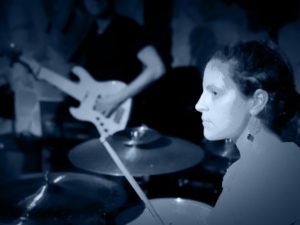
That’s me, playing at the Speakeasy two years later after deciding I’d see where lessons took me. What I assumed would be my loftiest goal, the end of the road–has only been the beginning. I implore you to start your own journey today!
by Amanda Pollak
There is a difference between a musician and someone who plays an instrument.
A musician makes it look easy. A musician becomes his instrument; you hear his soul bleed through the notes. You know her without ever having met her.
Everyone else is just making noise.
I have watched drummers play and I have watched people who play the drums. How I gravely underestimated the fortitude the former requires.
Yes, I’m aware of how dramatic I’m being, but only because preparing for my first gig has brought about a profound reflective state that I’ve yet to encounter before. Up until now, and with a few exceptions, I mostly digested new material when it was convenient for me–after the gym, after a nap, before going out for the evening. With over 50 songs to learn in a matter of weeks my peaceful approach has abruptly morphed into what feels like a subway system at rush hour, with my brain as the subway car and each song a disgruntled person clamoring for more space. Everybody in, doors closing, no room for anyone else.
By now you may have figured out that I made it into the band. The audition was way less stressful than I anticipated–for the first time I felt as though I was an equal as opposed to a little kid swinging her feet on a too-big chair at the adult’s table. I played well, although not perfectly, but I was reassured that my attitude was the most important instrument I could bring. My sense of accomplishment quickly subsided, however, when I was handed the set list with the understanding that I’d have it down by our first gig in a few weeks. Gulp.
In case any of my band mates read this, let me be clear: I am thrilled, honored, and utterly elated to even be in this position. As I’ve written before, this opportunity is quite literally an answer to prayer, and I welcome the challenge as an integral component of my percussive journey.
I suppose I didn’t anticipate this side of things, however. There’s a mechanical, detached approach I’ve adopted in order to commit as many songs into working memory as possible. Know the tempo, figure out when I come in, make note of rests and fills, try my best to capture the feel of the songs and never mind if it’s not 100% accurate, most people won’t realize anyway. Some songs come easier than others–and the ones that don’t have the ability to frustrate me on a level I find difficult to articulate. Certain fills, hits, pauses and entrances just trip me up, over and over and over, and each time I play along and miss a cue YET AGAIN, it’s as though I can feel my blood pressure climbing higher and higher. I hear Tony telling me to count it out, be certain, chart it–and I want to scream It’s not working! I can’t figure this beat out!
Eventually, I arrive at a place of resigned submission. Sometimes I ask others to listen and interpret, and other times I surprise myself with my capacity to replicate what I hear. But this is exhausting. This is not sexy and loose and wild like the performances I idolize. This is drudgery, not art. It is a checklist, a day at the office, a chore to be endured.
And it is vital. It is necessary. Because my goal is to be a drummer, not simply someone who plays the drums.
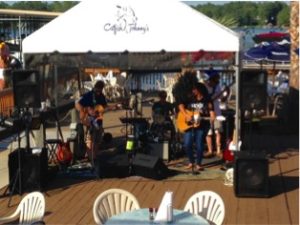
by Amanda Pollak
The gig is over. I feel like I arrived a preschooler and left a high school graduate. All of the experiences I’ve had paved the way for this experience, but nothing could have truly prepared me.
Above are a few of the thoughts I scribbled down as soon as I returned home from my first gig with the band, as the endorphins were just beginning to fade and the fatigue of a four hour set in June’s humidity set in. I managed mostly staccato sentences, just enough to capture the novelty of this experience, so that one day when I’m so much further than I am now, I’ll look back and remember what it felt like to do this for the first time.
We get through “I Know a Little.” People dance to it; the man dips her too far, she falls. We go out of order, choosing songs from our setlist to match the crowd. I’m used to having a second or two to collect myself, but that’s in the past, it seems. We move steadily through the songs. Now there’s an hour left. I feel at ease.
Before I arrived to set up, I took a fellow bandmate’s advice and loaded up on starch (by eating an entire box of macaroni and cheese) to ensure my reserves would remain undepleted. I felt a strange sort of resignation on the car ride there; I knew I had prepared, but I had the distinct feeling that it almost didn’t matter. I had spent hours both with the band and on my own rehearsing, but there’s an ocean of difference between playing in my air-conditioned apartment and performing live at a lakeside marina bar. The only way to learn it was to live it.
I attempted to prepare for all known variables–extra sticks (thanks, Tony!), drum key nearby, charts on the floor. As we started our first set, I was cautious and tense. Certain spots were looser than I liked. I had trouble reading the others when it was time to end, as this occasionally differed from what we had rehearsed. The after work crowd was beginning to filter in and it seemed like no one was reacting to us–here I was trekking through this enormous undertaking for which I’d spent countless hours preparing and fretting over, and the people surrounding me were none the wiser. Perhaps this sounds rather self-absorbed, but I was beginning to construe their non-involvement as a reflection of my performance. They’re not tapping their feet–is it because I’m not keeping time well? Did they hear me just flub that fill?
But then, a woman at a table (who I swore was scowling at me) got up and placed a $20 bill in our tip jar. And I had my first realization (of many to come) that this whole thing wasn’t about me. Yes, this was significant. Yes, it was an accomplishment and something to be proud of. For me. But to everyone else, this was another Friday afternoon at the lake. They were here to drink beer, order fries, and bop along to songs they know. They were not scowling at me. They were not judging my doubles. No one cared that I chose to stay on the hi-hat during the chorus instead of moving to the ride cymbal.
Once I worked through that realization, it became a lot easier to be present in the moment as opposed to locked away in my own mind with my anxieties and worst case scenarios. I was relieved to take a break, but as we began the next set, I suddenly felt more comfortable. The crowd was interacting with us more and I began to tap into their energy. I was executing fills I’d never rehearsed before but somehow managed to construct on the spot. There was a time in the past when I could only play what I’d practiced all while never breaking eye contact with my hi-hat, but today I could easily focus on the other musicians in front of me and the crowd around me.
Later in the evening during a guitar solo, I felt something I’d never experienced before while playing. The sun had disappeared; the shadowy faces in the audience were all I saw as the intensity of the solo was building. I picked up on this and decided to go to the snare and floor tom, ending with 16th notes on the snare, then incorporated more runs on the toms until bringing everything back down. It was unplanned. It was fluid. It was alive.
All the hours I’d spent charting and rehearsing had served me well, yet in that moment, I profoundly understood that music is a living, breathing entity; its rules negotiable, its structure in perpetual fluctuation. Where before I once felt so limited by my ability, I now experienced a gracious freedom to inject my own interpretation, which was as valid as anyone else’s.
Some other noteworthy events: I handled two audience requests, maintained composure while an inebriated individual attempted to steal the mic away from our singer, and no sticks were dropped.
And then, before I knew it, we were done.
I felt a mix of relief that I’d gotten through the show without massively screwing up, pride in being able to pull this accomplishment off when, just a year ago, I was on edge before performing just one song at the Speakeasy, and a bit of intimidation because there were so many things I’d become aware of in the past four hours, such as the importance of tuning my drums and my need to go back and work on triplets and shuffles and and and–
–it was okay. It was all going to be okay. I’d get there in time, just like I got here.
by Amanda Pollak
I’ve been taking drum lessons for a little over three years at Freeway Music. Those who know me have often heard me express that my one regret in life is that I didn’t begin sooner. Yet, entering this realm as an adult–and a woman–consistently leaves me feeling like I’ve got something to prove. Some days, I am on top of the world; other days, the jury’s still out.
As I write this, the desire to make my musical case remains strong, for in a few days, I’ll be auditioning for a local band. I saw the opportunity posted on a cork board in Freeway Music and reached out expressing my interest. “The worst they can say is no,” I thought.
I was given a list of songs the band covers and asked to learn three for the audition. I already knew how to play a few others on the list so I decided I’d bring those to the audition as well.
Off to a good start.
I approach learning new material by listening and trying to play along first, then breaking it down further if need be and perhaps even charting the song (which, by the way, Tony says I should do for every song, every time, right away). If I’m being honest, I dread charting and hardly ever do it. It feels tedious and in my misplaced pride, I feel as though I should just be able to listen to the song and immediately hear all the parts, even though this is ultimately more time-consuming and inefficient, not to mention an unrealistic expectation.
I pull up the first new tune, “Pride and Joy” by Stevie Ray Vaughan. Okay, simple enough. I begin to play along. But wait. Is the kick played there or there? It’s feeling like a shuffle and shuffles always trip me up…now I’m fumbling the beat, getting lost in the instrumentation and bass line, and as quickly as I start, I stop. There’s a brief moment of panic. Maybe I can’t do this after all. I consider sending a text explaining that, on second thought, this was too much and maybe keep me in mind for next time. I envision the audition, me dropping the beat and everyone else shooting me that look. You know the one.
Typical me, jumping to the worst case scenario. I could give up now. I suppose that would be fine. But, then I’d be in the exact same spot as I was before all of this began. Part of me–no, much of me–struggles with tying my self-worth into how well I can play. Drumming is something I love doing and I want others to love hearing me do it. So if they don’t, what does that say about me?
But I’m more than my drum kit. And I imagine that every musician I even halfway respect has wrestled with feeling incompetent. I could succumb now and keep drumming in my room for no one else to hear, or I could choose to move forward.
So I pause. Breathe. Take it slow. Find the 2 and 4. Distill the beat down to its basic elements. Tap it out, count the measures, be sure of the rests and fills. It doesn’t need to be an inerrant replica of the original; make it my own; retain the essence. Chart it, as tedious as it feels. Do the hard work here, now, on the beginner kit I bought three years ago before I ever even imagined I’d be in a position to audition for a band. Yes, they can say no. But I will keep moving forward.
21st century technology is incredible. 100 years ago, I bet nobody would have believed that computers, tablets, Kindles, iPads, and cell phones would exist, and that these devices would connect people across the globe, provide instant access to information, and allow us to have the world available to us at our fingertips. The intersection of music and technology provides endless opportunities for the modern musician. In a series of posts, I would like to outline various resources that I believe are essential to any musician interested in making the most of their personal tech.
Perhaps the century’s most iconic technological invention is Apple’s iPhone. For those who have Apple products, there are several services which make your smartphone a virtual gold mine of musical resources. To help navigate the endless possibilities, I wanted to compile a list of apps I have personally tested and use on a regular basis. These apps are useful for the early beginner to the trained professional and I would recommend them to my own students! The prices for these apps range from $0 to about $7.00, so they are a relatively low-cost investment as well.
Cleartune, $3.99
To start, I would recommend that anyone who is comfortable with tuning their instrument should invest in the Cleartune app. There are many apps available to help musicians tune, but this one is great because it offers a very clear tuning mechanism. All you do is correctly adjust the strings of the instrument so the dial lights up green on the pitch. For violin, the strings (from left to right) would be G – D – A – E, and for viola they would be C – G – D – A.
If you already have a tuner, this app is still a good investment in case the battery dies or you forget your tuner. For the more advanced player, the tuner can assist in playing drones for pitches chromatically—this would be useful for practice with scales and arpeggios. For sections of music with obscure accidentals or difficult patterns, the tuner can also target intonation.
Pro Metronome, Free
A metronome is an essential part of a balanced practice routine! The beginner violinist can use the “Tap” feature to set a beat. All you do is tap the button with the speed you want and then press the play button. This could be used for rhythm practice or playing beginner songs with different beats. Starting early with a metronome will be helpful to establish a sense of rhythm and pulse.
For the more experienced player, the metronome offers varying speeds, accents, and time signatures. You can set it to help you practice difficult passages more slowly or to make sure you are accurately performing rhythms on more challenging sections of music. I believe you can also purchase an upgraded version of the app for a few dollars, which allows you to use a lot of different settings (such as subdivisions, obscure time signatures, etc.).
The Most Addicting Sheep Game, $0.99
Along with the theme of pulse and rhythm, this cute game can be used by string players of any age to practice developing the concept of internal rhythm. The app plays music at varying tempos and your job is to complete the entire song by tapping the rhythms, which helps the sheep jump with the music. Young kids can enjoy the whimsical theme of the game while unconsciously honing their musical skills and advanced players can use the game to help refine their motor skills and advance to more difficult levels and patterns of music.
Anytune, Free
The Anytune app is ideal for intermediate to advanced players, where they can check in with their practice. The app allows you to record yourself (I recommend using the voice memo option) and play it back; however, the cool part of the app is that you can slow down various sections and listen to them in a slower tempo. So, you can play your music and slow it down to check your rhythm and intonation.
If you have any music in your iTunes that you want to play/practice, you can also select it in Anytune and use the same slow-down capabilities. This allows you to hear your music at a relaxed tempo. For practice purposes, you can play along with a slowed down piece or you can use it to listen and practice memorization. You can either shadow with your left and/or right hand or try imagining playing the piece along with the recording. I also believe there is the option to upgrade and receive more capabilities to alter the music of your choice.
Practice Journal, Free / Pro 6.99
Finally, the Practice Journal app is one I recommend for very organized intermediate players or advanced players (old enough to type into a phone). This app has a built-in metronome and it helps you document every practice session you complete. You can create folders for different elements of practice—Scales/Arpeggios, Etudes, Drills, Performance Pieces, etc. You can even time how long you play each section, giving insight into just how much you are practicing. You can write reflections on what you worked on, plan different strategies, and keep track of progress in the blank sections provided. The practice journal is great for people who want to be organized, but don’t want to carry around a notebook all the time. The ability to look through your progress is great, so you can see exactly how much you are accomplishing in your practice! The basic app is free, but only allows you to have a certain number of sections. The $6.99 upgrade allows for unlimited entries, which is awesome if you have a lot of goals for practicing!
